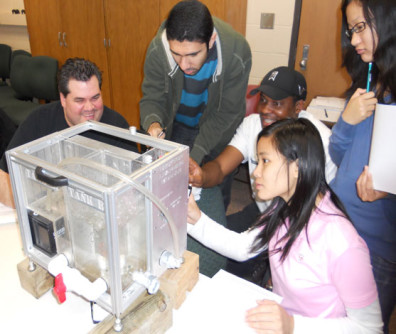Voiland Researchers are National Leaders in Engineering Education for 2010
sue@susanweaver.net
“We need to teach our kids that it’s not just the winner of the Super Bowl who deserves to be celebrated, but the winner of the science fair.”
– Barack Obama, 2011 State of the Union address
With government and industry leaders calling for innovation as a way to stay competitive in a global economy and for improved education, particularly, in engineering and sciences, a group of Washington State University researchers is taking a leading role in the field of engineering education.
Three faculty members in WSU’s Gene and Linda Voiland School of Chemical Engineering and Bioengineering received approximately 10 percent of the $18 million awarded nationally by the National Science Foundation’s Transforming Undergraduate Education in Science, Technology, Engineering and Mathematics (TUES) program, more research money in 2010 than any other academic department in the United States. The program provides research support for the improvement of curricula and teaching methods in science, technology, engineering, and mathematics (STEM) fields.
“If we are to meet the national call to be technology leaders in the 21st century, we need to be innovative in the way that we educate our students and bring the best education tools into our classrooms,” strong funding support speaks very well to the cutting-edge work we’re doing in this area.”
In 2005, WSU researchers from the College of Engineering and Architecture and the College of Education established the Engineering Education Research Center to facilitate research enabling innovation and effectiveness in engineering education. Led by Denny Davis, professor in the Voiland School, the research center has led and encouraged engineering education research that now is one of the larger research thrusts at WSU.
Voiland school researchers were also leaders in establishing the first-ever research experience program for junior high school and high school teachers in the United States. The SWEET (Summer at WSU Engineering Experiences for Teachers) program, which was initiated by three faculty from the Voiland School (Jim Petersen, Bill Thomson and Richard Zollars) and has subsequently been established at a national level, introduces teachers to engineering and helps them develop learning modules that they can bring back into their classrooms.
In 2010, three Voiland School researchers received support for the following engineering education NSF TUES funded projects:
- Multi-Disciplinary Project-Based Paradigm that Uses Hands-on Desktop Learning Modules and Modern Learning Pedagogies. Led by Bernard Van Wie, professor in the Voiland School, this $600,000 project expands on an earlier project that developed a prototype desktop learning module (DLM). The DLM is a desktop apparatus with multiple, easily interchangeable cartridges that can be reconfigured to perform a variety of experiments. This apparatus is being used in classrooms for implementing better teaching practices and demonstrating basic concepts in fluid mechanics and heat transfer.
- Appraisal System for Superior Engineering Education Evaluation-instrument Sharing and Scholarship (ASSESS). Led by Denny Davis, professor in the Voiland School, the purpose of this $600,000 project is to create a web-based library of proven engineering education evaluation instruments to help build evaluation capacity for the engineering education community.
- Exploring Studio-Based Learning in Chemical Engineering Education. Led by Richard Zollars, professor in the Voiland School, this $600,000 project builds on a previously developed scaffolded software environment called ChemProV (Chemical Process Visualizer). ChemProV presents chemical engineering students with dynamically-generated feedback on the syntactic and semantic correctness of their evolving process flow diagrams and sets of equations, guiding them toward correct solutions.
In addition to these projects in engineering education, Shane Brown, assistant professor in the Department of Civil and Environmental Engineering, also received a $400,000 National Science Foundation CAREER grant for a four-year project to better understand how practicing civil engineers gain understanding of engineering concepts. He hopes to develop a model of engineering thinking about these concepts and to create improved curricular materials based on this research.





